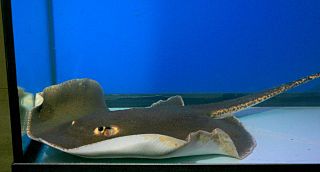
The roughback whipray is a rare species of freshwater stingray in the family Dasyatidae, found over sandy bottoms in the Mae Klong and Chao Phraya Rivers of Thailand. Growing no more than 29 cm (11 in) across, this small ray has an oval pectoral fin disc and a whip-like tail without fin folds. It closely resembles the white-edge freshwater whipray in appearance, but can be distinguished by its coloration: light gray to dark orange-brown above and white below with a dark band along the lateral margins. Another identifying feature is a "pearl organ" at the center of the back, found in individuals of all ages. All of the original specimens of the roughback whipray were found with extensive wounds to the fins and tail. The International Union for Conservation of Nature (IUCN) has assessed this species as Endangered, citing the extensive habitat degradation and heavy fishing pressure within its limited range.

Dasyatis is a genus of stingray in the family Dasyatidae that is native to the Atlantic, including the Mediterranean. In a 2016 taxonomic revision, many of the species formerly assigned to Dasyatis were reassigned to other genera.
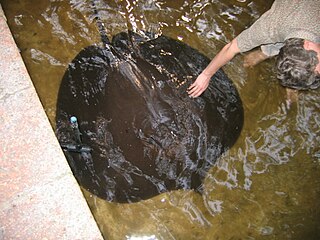
The giant freshwater stingray is a species of stingray in the family Dasyatidae. It is found in large rivers and estuaries in Southeast Asia and Borneo, though historically it may have been more widely distributed in South and Southeast Asia. One of the largest freshwater fish in the world, this species grows upwards of 1.9 m (6.2 ft) across and may reach 600 kg (1,300 lb) in weight. It has a relatively thin, oval pectoral fin disc that is widest anteriorly, and a sharply pointed snout with a protruding tip. Its tail is thin and whip-like, and lacks fin folds. This species is uniformly grayish brown above and white below; the underside of the pectoral and pelvic fins bear distinctive wide, dark bands on their posterior margins.

Himantura is a genus of stingray in the family Dasyatidae that is native to the Indo-Pacific. In a 2016 taxonomic revision, many of the species formerly assigned to Himantura were reassigned to other genera.

The marbled whipray is a little-known species of stingray in the family Dasyatidae, native to several freshwater rivers in Southeast Asia. This species has an oval pectoral fin disc with an elongated, pointed snout and a very long, whip-like tail without fin folds. It is characterized by numerous heart-shaped dermal denticles and tubercles on its upper surface, as well as a reticulated pattern of brown blotches on a light background. The maximum recorded disc width is 36 cm (14 in). The marbled whipray has been assessed as Endangered by the International Union for Conservation of Nature (IUCN); it is heavily threatened by fishing and habitat loss, degradation, and fragmentation.
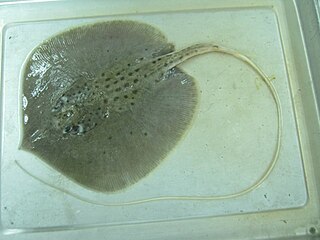
The white-edge freshwater whipray is an extremely rare species of stingray in the family Dasyatidae, native to four river systems in Southeast Asia. Measuring up to 60 cm (24 in) across, this ray has an oval pectoral fin disc and a very long, whip-like tail without fin folds. It can be identified by the presence of a sharply delineated white band running around the margin of its otherwise brown disc, as well as by its white tail and a band of dermal denticles along the middle of its back. This species feeds on benthic invertebrates and is aplacental viviparous. Its two long tail spines are potentially dangerous to humans. The International Union for Conservation of Nature (IUCN) has assessed the white-edge freshwater whipray as Endangered, as it is under heavy pressure from fishing and habitat loss, degradation, and fragmentation.

Urogymnus is a genus of stingrays in the family Dasyatidae from marine, brackish and freshwater habitats in the Indo-Pacific and tropical East Atlantic regions. The genus was previously considered to be monotypic, containing only the porcupine ray. Molecular phylogenetic research published in 2016 reassigned several species from Himantura to Urogymnus.

The whiptail stingrays are a family, the Dasyatidae, of rays in the order Myliobatiformes. They are found worldwide in tropical to temperate marine waters, and a number of species have also penetrated into fresh water in Africa, Asia, and Australia. Members of this family have flattened pectoral fin discs that range from oval to diamond-like in shape. Their common name comes from their whip-like tails, which are much longer than the disc and lack dorsal and caudal fins. All whiptail stingrays, except the porcupine ray, have one or more venomous stings near the base of the tail, which is used in defense. They range in size from 0.18 to 2.0 m or more across.

Taeniura is a genus of stingrays in the family Dasyatidae. The species Taeniurops grabata and T. meyeni were formerly placed in this genus. However, phylogenetic research has shown that these two species are not closely related to T. lymma, and they have been assigned to a separate genus, Taeniurops.
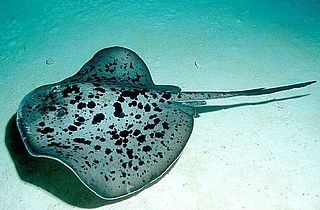
Taeniurops is a genus of stingrays in the family Dasyatidae. Its two species were formerly contained within the genus Taeniura.

Bathytoshia is a genus of stingrays in the family Dasyatidae found worldwide in tropical and warm temperate oceans. It was formerly regarded as a junior synonym of the genus Dasyatis.

Hemitrygon is a genus of stingrays in the family Dasyatidae from marine, brackish and freshwater habitats in the central Indo-Pacific and northwest Pacific regions. The genus was formerly regarded as a junior synonym of the genus Dasyatis.

Hypanus is a genus of stingrays in the family Dasyatidae from warmer parts of the East Pacific and Atlantic, including the Caribbean and Gulf of Mexico. The genus was previous regarded as a junior synonym of the genus Dasyatis.

Telatrygon is a genus of stingrays in the family Dasyatidae from the central Indo-Pacific. Its species were formerly contained within the genus Dasyatis.
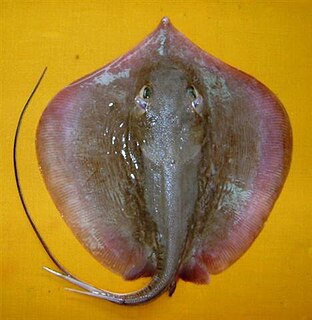
Brevitrygon is a genus of stingrays in the family Dasyatidae from the Indo-Pacific. Its species were formerly contained within the genus Himantura.
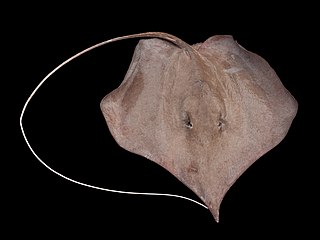
Fontitrygon is a genus of stingrays in the family Dasyatidae found in coastal tropical Atlantic waters and rivers that drain into the Atlantic. Fontitrygon species were formerly contained within the genus Dasyatis.

Maculabatis is a genus of stingrays in the family Dasyatidae from the Indo-Pacific. Its species were formerly contained within the genus Himantura.

Pateobatis is a genus of stingrays in the family Dasyatidae from the Indo-Pacific. Its species were formerly contained within the genus Himantura.
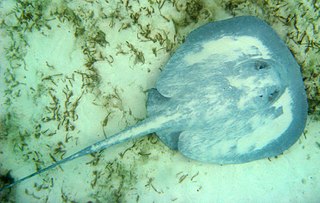
Styracura is a genus of stingray in the family Potamotrygonidae and the only genus in the subfamily Styracurinae. The two species in this genus were formerly included in Himantura, but were moved to Styracura in 2016 based on morphology and molecular evidence. Unlike other members of the family Potamotrygonidae, also known as freshwater stingrays, Styracura are found in the tropical West Atlantic and East Pacific.

The mumburarr whipray is a species of whipray from northern Australia and southern Papua New Guinea, described in 2016.




















